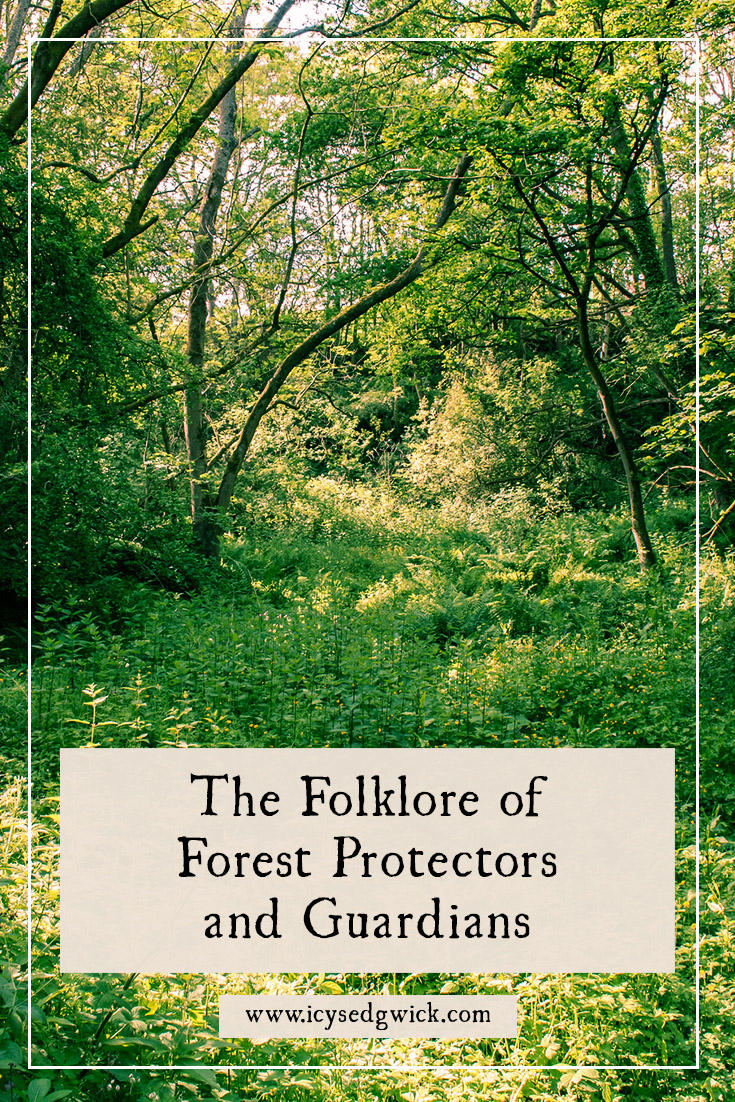Forests are ambivalent places, both beautiful and tranquil, yet also dangerous to the unwary. They’ve always been a source of resources for people, which is either embraced or exploited. As a result, there is a whole class of folklore involving forest protectors, spirits who guard the woods and all the animals within. These protectors ensure that humans never take more than they should, and keep the forest in balance.
Not all forest-dwelling spirits and gods are guardians of the forest. Look at dryads, which are the spirits of specific trees rather than the woods as a whole.
In this post, we’re more interested in spirits that protect the forest. They are the ones who punish greedy humans, or lead those with ill intentions out of harm’s way.
I’ve already covered Silvanus, the Roman god of the forest. You can also find Muma Padurii, Papa Bois, Mapinguari and La Madremonte in Rebel Folklore. In this post, we’re going to focus on the Leshy, the Wood-Wives, and even the pangolin!
The Leshy
The Leshy is a forest spirit in Slavic mythology. He protects the forest and its animals. Many consider the Leshy a trickster, particularly for his shapeshifting abilities. He might appear to someone as a man to confuse anyone in the forest or to lead them astray. One favourite trick was to lead them right into the centre of the woods, where he’d abandon them with a laugh.
Sometimes, the Leshy didn’t even need to appear in order to lead them astray. Sometimes he would manipulate the forest so an unwary traveller might find each path looking the same. That said, the Leshy was a trickster, not malevolent, so if the traveller had genuine intentions, the Leshy might make the true path appear, and guide the traveller back to a safe route. With any luck, the traveller would learn a lesson (Mythical Creatures, no date).
Descriptions of his appearance vary. In some accounts, he has pale green skin, while in others, his skin appears grey or blue. Other descriptions see him appear as a human, albeit one missing a right ear, eyebrows, and eyelashes (Britannica 2023). Despite this, the Leshy is more often heard than seen, either laughing or singing (Britannica 2023).

Whilst in the forest, the Leshy stood as tall as a tree, though if he left, he became the height of a blade of grass (Britannica 2023)(Porteous 2002 [1928]).
If you wanted to invoke one, you would cut down young birch trees and put them in a circle, with the tops pointing to the centre. You entered the circle and invoked the spirit. Next, you stepped onto one of the birch stumps, turned your face east, and bent over to look between your legs. If you did this, you said, “Uncle Lieschi, ascend thou, not as a grey wolf, not as an ardent fire, but as resembling myself.” Having done so, the Leshy would stand up in human form and do whatever it was the person invoked him to do. The price? Your soul (Porteous 2002 [1928]).
Those entering the forest for practical reasons, like hunting or searching for firewood, should leave offerings. This would show the Leshy that you understood the rules of the forest and wouldn’t overstep the boundaries. Otherwise, the Leshy would work to keep the forest in balance.
The Wood-Wives
The Wood-Wives lived in ancient forests, and they’re a little like dryads in that their lives depended on the forest being healthy. They often appear in German folklore, especially from southern Germany, as well as Scandinavia. They’re described as tiny, beautiful, pale, and they wear blue, red, or green dresses.
In some ways, they’re similar to the Skogsra of Sweden, except the Skogsra had claws. They were friendly to everyone except hunters, and savvy hunters knew to leave a portion of their catch for the Skogsra (Porteous 2002 [1928]).
The Wood-Wives apparently sat in the court of the ancient gods in their sacred forests (Porteous 2002 [1928]). They were generally benevolent. If you lived in the forest, or along its edge, and you were baking, you could expect a Wood-Wife to turn up. She’d ask you to bake her a cake. If you did so, she’d leave wood chips behind, and these turned into gold coins. Unlike fairy gold, which habitually turns back into leaves, these coins would never change form unless you told someone how you came by them. You could also earn these coins by fixing their tools or giving them something to eat from your pot (Porteous 2002 [1928]).
The Dirne-weibl lived in Bavaria. She usually wore white, although, in one forest, she wore red. This Wood-Wife wandered the forest, ready to hand over a basket of apples. It was a good idea to accept it because it turned to gold. The downside was she would then ask the recipient to accompany her. Whoever refused made her cry, and she’d return to the wood. Still, it was a good idea to help the Wood-Wives if you came across them. A legend told of a poet who met a Wood-Wife in the forest. He agreed to go with her, and she took him to Dame Charity’s tower. After they had a chat, Dame Charity sent him away with treasure (Porteous 2002 [1928]).
The Wood-Wives’ Foe
Woodcutters grew fond of the Wood-Wives – and to be fair, they sound rather sweet. Woodcutters cut crosses into tree stumps to help the Wood-Wives during the Wild Hunt. The Huntsman would chase Wood-Wives through the forest for sport, but the Wives could hide in these cross-marked tree stumps (Porteous 2002 [1928]). It feels like the woodcutters marking the stumps was their way of paying something back to the forest that gave them a living.

Miss Jessel makes the point that the Wild Hunt suffered something of a PR crisis with the coming of Christianity, with these ancient gods turned into demonic spirits, intent on evil sport (2021). In this new version, the Huntsman (and his identity changed depending on the story) hated the Wood-Wives and all they stood for. Where the Wood-Wives protected the forest and all life within it, the Huntsman simply wanted to destroy. That said, there are stories in which the Huntsman met a sticky end, believed to be the work of angry Wood-Wives intent on protecting the forest (Jessel 2021).
Huntsmen in particular suffered at the hands of Wood-Wives, and stories spread around Germany of hunters found with their throats cut during the 16th and 17th centuries (Amanda, no date).
Moss Folk
There are also tales of the Moss Folk, who are confusingly sometimes called Wood-Wives too. They would actually come to humans for help, or to borrow things, and those that helped received gifts or useful advice as payment (Miss Jessel 2021).
Compared to the Wood-Wives, people considered the moss folk to be dwarfs, and they lived in groups. The Moss Folk were grey, often looked old, and were overgrown with moss (Porteous 2002 [1928]).
They often tended to sick animals, and they would help people find medicinal plants in the forest during times of plague. That said, if anyone refused to help, or refused their payment, they got very angry (Miss Jessel 2021).
Like the Wood-Wives, they’re not forest protectors in the same way the Leshy is, but they do represent the dual nature of the forest. On one hand, it can provide bountiful resources, and on the other, it contains things that can and will kill you.
Other Spirits and Deities
Pulch lived in the Kammerforst, some 103 miles northeast of Frankfurt. He chastised anyone who injured the trees or stole wood (Porteous 2002 [1928]). Likewise, large numbers of the Waldgeister lived in ancient forests – literally forest spirits. Some had a benevolent nature, while others were malevolent in nature. The Waldgeister knew the secrets of medicinal plants. The Hylde-moer, or Elder Mother, was a Waldgeister who lived in elder trees. She avenged any damage done to elder trees, and if you wanted to cut down an elder, you had to seek the Hylde-moer’s permission first (Porteous 2002 [1928]).
In Estonia, the Metsik lived in aspen trees in the forest. People held them in such awe that they didn’t break off tree branches or even pick flowers if they fell in the shadow of the tree (Porteous 2002 [1928]). The Metsik hid in their tree’s roots during a thunderstorm. Like other forest guardians, the Metsik led those away who wanted to cut down trees or set fires (Pekantytär 2021).
Meanwhile, in Finland, all wild animals in the forest belonged to Tapio, the forest god. Hunters had to seek his permission before venturing into the forest on a hunt. They also made offerings to encourage Tapio to send game their way. Surprisingly, Tapio also protected domestic cattle, whether they were in the stall, or they’d wanted into the forest (Porteous 2002 [1928]).
The Curupira of Brazil will likewise ensure any who come into the rainforest with destruction in mind finds themselves lost. He took the form of a young boy with backwards-facing feet, which created false trails that confused humans. He’s often blamed when people disappear in the forest. His stories date to the days of colonisation, so it’s possible that he appeared as a counter-balance to the deforestation that began in the wake of incoming Europeans (G.S. 2016).
The Pangolin
It might seem strange to see the pangolin alongside figures like the Leshy and Silvanus, but I got the idea to include them when Wild Aid called them “forest guardians” on Instagram. They’re guardians in a very literal sense since their fondness for ants and termites protects trees and promotes soil health in the forest. Pangolins are the world’s only scaled mammal, and they’re the most trafficked mammal, currently risking extinction. Both habitat loss and the trade for their meat and scales mean we risk losing this shy mammal altogether.
But they also appear in folklore, so it’s worth looking at the role they play in mythology too.

Their scientific name, Manis comes from ‘manes’ in Latin, which means ‘ghost’ or ‘spirit of the dead’ (Gaubert 2017). It actually refers to their nocturnal life, but it also suggests how mysterious people found them (Newman 2018).
In some parts of Tanzania, the Sangu people believed pangolins fell from the sky, dispatched by their ancestors. Every pangolin latched onto a person when they arrived, and followed them home. If you were ‘chosen’ by a pangolin, you underwent special rituals, including singing and dancing. If the pangolin cried while dancing, this was an omen of rain in the coming year (Newman 2018).
Zimbabwe lore sees pangolins as a good luck symbol, meaning it brings bad luck to kill one (Newman 2018).
Meanwhile, in Taiwanese lore from the Kanakanavu people, the pangolin rescued a woman thrown into a ravine by her husband. The woman, Pei, held onto the pangolin’s tail as he tunnelled back to her village (Chao 2023).
In Tsou mythology, the pangolin plays the role of a trickster. He made a bet with a fox over who could survive a fire. The fox stood amid the burning grass, but the pangolin burrowed underneath. It’s not all bad; the pangolin put out the flames and saved the fox’s life once he won the bet (Chao 2023).
Whatever the mythology though, these shy creatures are vital to the health of the forest and to their eco-system. They’re going to need every scrap of help they can get if they’re going to survive. In their case, we need to become their guardians.
What do we make of these forest protectors?
Forests are complex eco-systems and if they’re left alone, they’ll often seemingly balance themselves. But too often, humans interfere and knock that balance out of kilter.
It’s hardly surprising that people might have considered forest guardians to be both benevolent and dangerous, depending on your intentions. If you only wanted a little firewood and maybe some food for the pot, giving offerings to the guardians might even lead you to a forest bounty. But killing for sport or destroying swathes of the forest would only anger these guardians. While it’s unclear how much people genuinely feared reprisals, the threat of such elemental anger is certainly a potent one.
Of course now, such threats are likely to be met with laughter, rather than respect. In Britain, developers can cut down established ancient forests, claiming they’ll replant trees elsewhere, but this is no replacement. Saplings cannot do the job of mature trees, and it’s destructive to remove an established habitat with the promise of a new one that can’t replicate the original. With such a mindset alive and well in the 21st century, the best forest protectors in the British Isles are often ordinary people.
We need to be our own forest guardians.
Which of these forest protectors is your favourite?
References
Amanda (no date), ‘Beware the Vengeful Wood Wives’, Vampires, https://www.vampires.com/beware-the-vengeful-wood-wives/.
Britannica, T. Editors of Encyclopaedia (2023), ‘The Leshy’, Encyclopedia Britannica, https://www.britannica.com/topic/leshy.
Chao, Min (2023), ‘Taiwan Nature: Pangolin mythology, conservation, and diplomacy’, Medium, https://wordsfromtaiwan.medium.com/taiwan-nature-pangolin-mythology-conservation-and-diplomacy-72e26aa31ed.
Gaubert, Philippe, Agostinho Antunes, Warren E. Johnson and Shu-Jin Luo (2017), ‘Using evolutionary history to save pangolins from extinction’, OUPblog, https://blog.oup.com/2017/12/evolutionary-history-to-save-pangolins-from-extinction/.
G.S. (2016), ‘Curupira – The Forest Guardian’, Latin Folk Tales, https://latinfolktales.wordpress.com/2016/02/23/curupira-the-forest-guardian/.
Miss Jessel (2021), ‘Wood-Wives, the Quarry of the Wild Huntsman’, Haunted Palace, https://hauntedpalaceblog.com/2021/12/03/wood-wives-the-quarry-of-the-wild-huntsman/.
Mythical Creatures (no date), ‘Leshy’, Mythical Creatures, https://mythicalcreatures.info/characters/leshy/.
Newman, Paul (2018), ‘Can the power of cultural mythology help give pangolins more than the ghost of a chance?’, Environmental Investigation Agency, https://eia-international.org/blog/can-power-cultural-mythology-help-give-pangolins-ghost-chance/.
Pekantytär, Niina (2021), ‘Estonian Folklore’, Newsbreak, https://original.newsbreak.com/@niina-pekantyt-r-1589868/2400243490611-estonian-folklore.
Porteous, Alexander (2002 [1928]), The Forest in Folklore and Mythology, New York: Dover (aff link).
Nutty about folklore and want more?
Add your email below and get these posts in your inbox every week.
You'll also get my 5-step guide to protecting your home using folklore!










Wonderful episode – lots of resources to check out